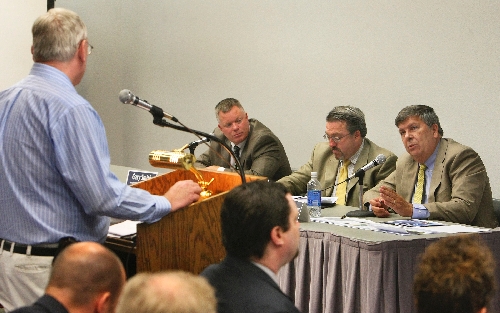Few consumers speak out on NV Energy resource plan

NV Energy’s latest power-resources plan didn’t generate many sparks during consumer sessions held Monday at Cashman Convention Center.
About 15 consumers testified at two separate sessions featuring a panel of NV Energy executives and members of the state Public Utilities Commission.
NV Energy’s integrated resource plan, a 20-year proposal that it’s required to update every three years, details how the company will obtain, finance and distribute the electricity it sells to Nevadans. And ratepayers’ testimony showed little unified sentiment on how the newest proposal will affect them. Some ratepayers said they opposed the plan, while others praised it. A small number of consumers registered comments unrelated to the plan.
The two hottest topics were the company’s Advanced Service Delivery initiative and its plan for a new transmission line.
Through Advanced Service Delivery, NV Energy would replace all of Nevada’s 1.45 million electric meters with “smart meters” that let consumers track power use and enable NV Energy to charge different electric rates based on energy consumption during peak summertime hours, from 2 p.m. to 7 p.m. NV Energy would roll out a voluntary pilot program in the fall to test the concept. Full deployment would follow in 2012. NV Energy officials estimate the program will cost $301 million to implement. They’ve secured $138 million in federal stimulus funds to finance part of the launch; the remainder could come from higher power rates later.
Las Vegan Bruce Rugar wanted to know how much NV Energy’s share of the investment will raise his power bills. He also said he was skeptical that consumers would appreciate Advanced Service Delivery.
“Do you really think that your customers will benefit and thank you for imposing punitive time-of-use rates during sweltering summer afternoons?” he asked.
Barry Gold, director of government relations for AARP Nevada, called the meters “not-so-smart meters” and said charging more to consume energy in the afternoon could hurt seniors. Many elderly Nevadans already shut off air conditioners in hot weather to save on power bills, and variable pricing could mean even more seniors abandon cooling in the summer, he said.
“Using financial pressure to reduce consumption poses a potential threat to health and safety for vulnerable consumers who cannot afford peak prices and who are not able to shift essential energy usage to off-peak periods,” Gold said.
The two consumers who commented on NV Energy’s proposed transmission line said the line would benefit their green-energy businesses.
The 235-mile, $510 million transmission line would connect power grids in both halves of the state and link NV Energy to renewable electricity generated in Nevada’s rural areas. NV Energy would develop the line with LS Power of New York. The codevelopers have said stimulus funding will finance the line’s construction.
Rich Hamilton, president of Reno general contractor Clean Energy Center, said the line would mean better grid stability, and it would give power producers “a path to market” and deliver “low-cost” wind and geothermal energy to consumers.
“The ability of Nevada to transmit wind energy will allow our state to reduce the amount of money we export to other states for electricity and provide jobs in Nevada,” Hamilton said.
Before consumers spoke, NV Energy officials gave a 45-minute presentation explaining the resource plan’s biggest components.
Gary Smith, NV Energy’s project director of smart technologies, said Advanced Service Delivery would enable ratepayers to “take ownership” of their power use. Customers could sign up for use alerts — request a text message or e-mail when you hit $50 in a billing cycle, for example — and track average daily power consumption.
Advanced Service Delivery will also save NV Energy $35 million a year in operating costs, eliminating 1 million annual truck trips to turn on or shut off power, and 17 million manual meter reads a year.
Smith said NV Energy has developed a series of safeguards to protect consumer privacy and to ensure the new meters are accurate.
But Michael Saunders, an attorney with the state Bureau of Consumer Protection, said his agency is “very concerned” about the pricing uncertainties associated with smart meters. He added that he believes cost-benefit analyses of the meters are “highly speculative.”
The Public Utilities Commission must approve NV Energy’s integrated resource plan before the company could pursue the proposals.
Commissioners are scheduled to begin hearings in the case Monday at 10 a.m. in hearing room A at the agency’s Las Vegas office, at 101 Convention Center Drive, Suite 250. The commission will allow ratepayers to comment at the meeting’s beginning.
To see NV Energy’s integrated resource plan, visit www.puc.nv.gov. Click on “docket info” and select “electric dockets.” Choose dockets 10-02009 and 10-03023.